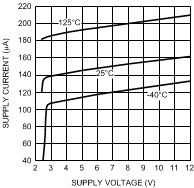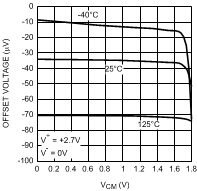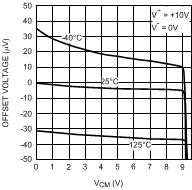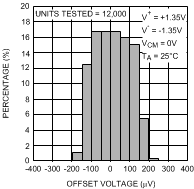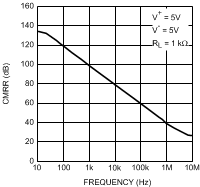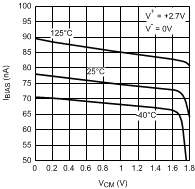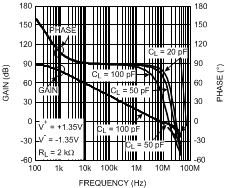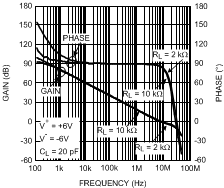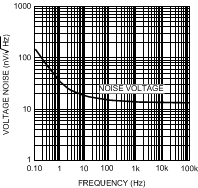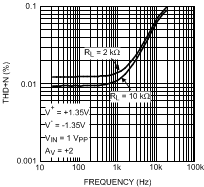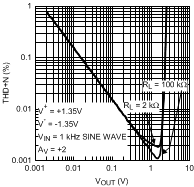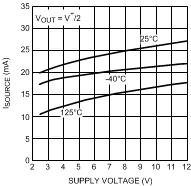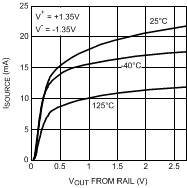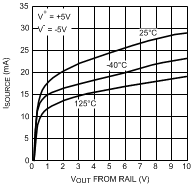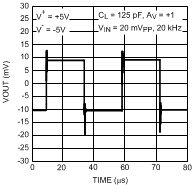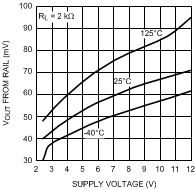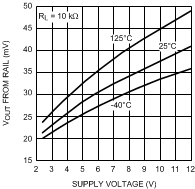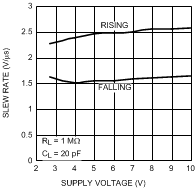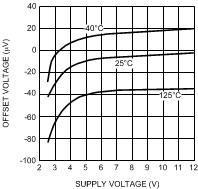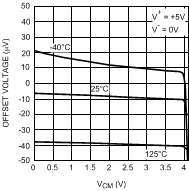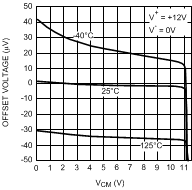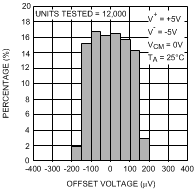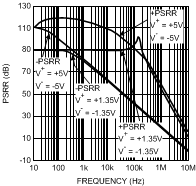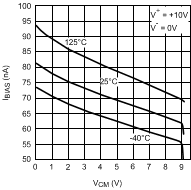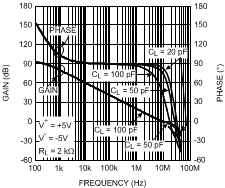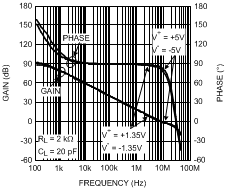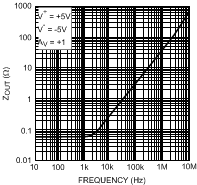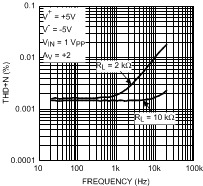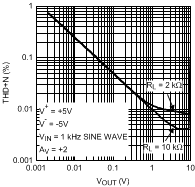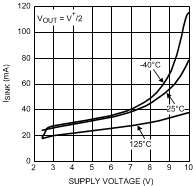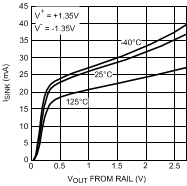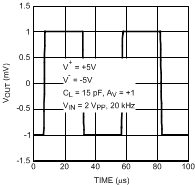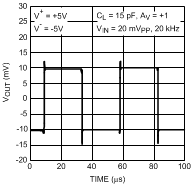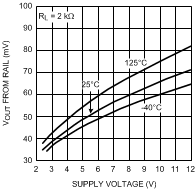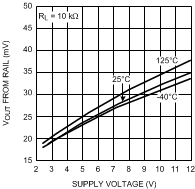JAJSAM4D September 2007 – August 2016 LMV641
PRODUCTION DATA.
- 1 特長
- 2 アプリケーション
- 3 概要
- 4 改訂履歴
- 5 Pin Configuration and Functions
- 6 Specifications
- 7 Detailed Description
- 8 Application and Implementation
- 9 Power Supply Recommendations
- 10Layout
- 11デバイスおよびドキュメントのサポート
- 12メカニカル、パッケージ、および注文情報
パッケージ・オプション
メカニカル・データ(パッケージ|ピン)
サーマルパッド・メカニカル・データ
発注情報
6 Specifications
6.1 Absolute Maximum Ratings
over operating free-air temperature range (unless otherwise noted)(1)(7)| MIN | MAX | UNIT | |
|---|---|---|---|
| Differential input VID | ±0.3 | ±0.3 | V |
| Supply voltage (VS = V+ - V−) | 13.2 | V | |
| Input and output pin voltage | (V− −0.3) | V+ +0.3 | V |
| Junction temperature (2) | 150 | °C | |
| Storage temperature, Tstg | –65 | 150 | °C |
6.2 ESD Ratings
| VALUE | UNIT | |||
|---|---|---|---|---|
| V(ESD) | Electrostatic discharge | Human-body model (HBM), (1) | ±2000 | V |
| Machine model (MM) | ±200 | |||
(1) Human Body Model, applicable std. MIL-STD-883, Method 3015.7.
6.3 Recommended Operating Conditions
over operating free-air temperature range (unless otherwise noted)| MIN | NOM | MAX | UNIT | ||
|---|---|---|---|---|---|
| Temperature (2) | –40 | 125 | °C | ||
| Supply voltage (VS = V+ – V−) | 2.7 | 12 | V | ||
6.4 Thermal Information
| THERMAL METRIC(1) | LMV641 | UNIT | |||
|---|---|---|---|---|---|
| DBV (SOT-23) | DCK (SC70) | D (SOIC) | |||
| 5 PINS | 5 PINS | 8 PINS | |||
| RθJA(2) | Junction-to-ambient thermal resistance | 325 | 456 | 166 | °C/W |
| RθJC(top) | Junction-to-case (top) thermal resistance | 178.1 | 121.8 | 93.6 | °C/W |
| RθJB | Junction-to-board thermal resistance | 60.8 | 68.9 | 90.9 | °C/W |
| ψJT | Junction-to-top characterization parameter | 57.7 | 5.3 | 38.4 | °C/W |
| ψJB | Junction-to-board characterization parameter | 60.2 | 68.1 | 90.4 | °C/W |
| RθJC(bot) | Junction-to-case (bottom) thermal resistance | n/a | n/a | n/a | °C/W |
(1) For more information about traditional and new thermal metrics, see the Semiconductor and IC Package Thermal Metrics application report.
6.5 DC Electrical Characteristics: 2.7 V
Unless otherwise specified, all limits are specified for TA = 25°C, V+ = 2.7 V, V− = 0 V, VO = VCM = V+/2, and RL > 1 MΩ.| PARAMETER | TEST CONDITIONS | MIN (4) |
TYP (3) |
MAX (4) |
UNIT | ||
|---|---|---|---|---|---|---|---|
| VOS | Input offset voltage | TA = 25°C | 30 | 500 | µV | ||
| Temperature extremes | 750 | ||||||
| TC VOS | Input offset average drift | 0.1 | µV/°C | ||||
| IB | Input bias current | TA = 25°C (5) | 75 | 95 | nA | ||
| Temperature extremes | 110 | ||||||
| IOS | Input offset current | 0.9 | 5 | nA | |||
| CMRR | Common-mode rejection ratio | 0 V ≤ VCM ≤ 1.7 V | TA = 25°C (5) | 89 | 114 | dB | |
| Temperature extremes | 84 | ||||||
| PSRR | Power supply rejection ratio | 2.7 V ≤ V+ ≤ 10 V, VCM = 0.5 | TA = 25°C (5) | 94.5 | 105 | dB | |
| Temperature extremes | 92.5 | ||||||
| 2.7 V ≤ V+ ≤ 12 V, VCM = 0.5 | TA = 25°C (5) | 94 | 100 | ||||
| Temperature extremes | 92 | ||||||
| CMVR | Input common-mode voltage range | CMRR ≥ 80 dB | TA = 25°C (5) | 0 | 1.8 | V | |
| CMRR ≥ 68 dB | Temperature extremes | 0 | 1.8 | ||||
| AVOL | Large signal voltage gain | 0.3 V ≤ VO ≤ 2.4 V, RL = 2 kΩ to V+/2 |
82 | 88 | dB | ||
| 0.4 V ≤ VO ≤ 2.3 V, RL = 2 kΩ to V+/2 | 78 | ||||||
| 0.3 V ≤ VO ≤ 2.4 V, RL = 10 kΩ to V+/2 | TA = 25°C (5) | 86 | 98 | ||||
| 0.4 V ≤ VO ≤ 2.3 V, RL = 10 kΩ to V+/2 | Temperature extremes | 82 | |||||
| VO | Output swing high | RL = 2 kΩ to V+/2, VIN = 100 mV | TA = 25°C (5) | 42 | 58 | mV from rail | |
| Temperature extremes | 68 | ||||||
| RL = 10 kΩ to V+/2, VIN = 100 mV | TA = 25°C (5) | 22 | 35 | ||||
| Temperature extremes | 40 | ||||||
| Output swing low | RL = 2 kΩ to V+/2, VIN = 100 mV | TA = 25°C (5) | 38 | 48 | |||
| Temperature extremes | 58 | ||||||
| RL = 10 kΩ to V+/2, VIN = 100 mV | 18 | 30 | |||||
| 35 | |||||||
| IOUT | Sourcing and sinking output current | VIN_DIFF = 100 mV to VO = V+/2 (6) | Sourcing | 22 | mA | ||
| Sinking | 25 | ||||||
| IS | Supply current | TA = 25°C (5) | 138 | 170 | µA | ||
| Temperature extremes | 220 | ||||||
| SR | Slew rate | AV = 1, VO = 1 VPP | Rising (10% to 90%) | 2.3 | V/µs | ||
| Falling (90% to 10%) | 1.6 | ||||||
| GBW | Gain bandwidth product | 10 | MHz | ||||
| en | Input-referred voltage noise | f = 1 kHz | 14 | nV/√Hz | |||
| in | Input-referred current noise | f = 1 kHz | 0.15 | pA/√Hz | |||
| THD | Total harmonic distortion | f = 1 kHz, AV = 2, RL = 2 kΩ | 0.014% | ||||
6.6 DC Electrical Characteristics: 10 V
Unless otherwise specified, all limits are specified for TA = 25°C, V+ = 10 V, V− = 0 V,VO = VCM = V+/2, and RL > 1 MΩ.| PARAMETER | TEST CONDITIONS | MIN (4) |
TYP (3) |
MAX (4) |
UNIT | ||
|---|---|---|---|---|---|---|---|
| VOS | Input offset voltage | TA = 25°C (5) | 5 | 500 | µV | ||
| Temperature extremes | 750 | ||||||
| TC VOS | Input offset average drift | 0.1 | µV/°C | ||||
| IB | Input bias current | (5) | TA = 25°C (5) | 70 | 90 | nA | |
| Temperature extremes | 105 | ||||||
| IOS | Input offset current | 0.7 | 5 | nA | |||
| CMRR | Common-mode rejection ratio | 0 V ≤ VCM ≤ 9 V | TA = 25°C (5) | 94 | 120 | dB | |
| Temperature extremes | 90 | ||||||
| PSRR | Power supply rejection ratio | 2.7 V ≤ V+ ≤ 10 V, VCM = 0.5 V | TA = 25°C (5) | 94.5 | 105 | dB | |
| Temperature extremes | 92.5 | ||||||
| 2.7 V ≤ V+ ≤ 12 V, VCM = 0.5 V | TA = 25°C (5) | 94 | 100 | ||||
| Temperature extremes | 92 | ||||||
| CMVR | Input common-mode voltage range | CMRR ≥ 80 dB | TA = 25°C (5) | 0 | 9.1 | V | |
| CMRR ≥ 76 dB | Temperature extremes | 0 | 9.1 | ||||
| AVOL | Large signal voltage gain | 0.3 V ≤ VO ≤ 9.7 V, RL = 2 kΩ to V+/2 0.4 V ≤ VO ≤ 9.6 V, RL = 2 kΩ to V+/2 |
TA = 25°C (5) | 90 | 99 | dB | |
| Temperature extremes | 85 | ||||||
| 0.3 V ≤ VO ≤ 9.7 V, RL = 10 kΩ to V+/2 0.4 V ≤ VO ≤ 9.6 V, RL = 10 kΩ to V+/2 |
TA = 25°C (5) | 97 | 104 | ||||
| Temperature extremes | 92 | ||||||
| VO | Output Swing High | RL = 2 kΩ to V+/2, VIN = 100 mV | TA = 25°C (5) | 68 | 95 | mV from rail | |
| Temperature extremes | 125 | ||||||
| RL = 10 kΩ to V+/2, VIN = 100 mV | TA = 25°C (5) | 37 | 55 | ||||
| Temperature extremes | 65 | ||||||
| Output Swing Low | RL = 2 kΩ to V+/2, VIN = 100 mV | TA = 25°C (5) | 65 | 90 | |||
| Temperature extremes | 110 | ||||||
| RL = 10 kΩ to V+/2, VIN = 100 mV | TA = 25°C (5) | 32 | 42 | ||||
| Temperature extremes | 52 | ||||||
| IOUT | Sourcing and sinking output current | VIN_DIFF = 100 mV to VO = V+/2 (6) |
Sourcing | 26 | mA | ||
| Sinking | 112 | ||||||
| IS | Supply current | TA = 25°C (5) | 158 | 190 | µA | ||
| Temperature extremes | 240 | ||||||
| SR | Slew rate | AV = 1, VO = 2 V to 8 VPP | Rising (10% to 90%) | 2.6 | V/µs | ||
| Falling (90% to 10%) | 1.6 | ||||||
| GBW | Gain bandwidth product | 10 | MHz | ||||
| en | Input-referred voltage noise | f = 1 kHz | 14 | nV/√Hz | |||
| in | Input-referred current noise | f = 1 kHz | 0.15 | pA/√Hz | |||
| THD | Total harmonic distortion | f = 1 kHz, AV = 2, RL = 2 kΩ | 0.002% | ||||
(1) Absolute Maximum Ratings indicate limits beyond which damage to the device may occur. Operating Ratings indicate conditions for which the device is intended to be functional, but specific performance is not guaranteed. For ensured specifications and the test conditions, see the Electrical Characteristics Tables.
(2) The maximum power dissipation is a function of TJ(MAX, RθJA. The maximum allowable power dissipation at any ambient temperature is PD = (TJ(MAX) - TA)/ RθJA. All numbers apply for packages soldered directly onto a PC board.
(3) Typical values represent the most likely parametric norm as determined at the time of characterization. Actual typical values may vary over time and also depend on the application and configuration. The typical values are not tested and are not specified on shipped production material.
(4) Limits are 100% production tested at 25°C. Limits over the operating temperature range are specified through correlations using Statistical Quality Control (SQC) method.
(5) Positive current corresponds to current flowing into the device.
(6) The part is not short-circuit protected and is not recommended for operation with low resistive loads. Typical sourcing and sinking output current curves are provided in Typical Characteristics and should be consulted before designing for heavy loads.
(7) If Military/Aerospace specified devices are required, contact the Texas Instruments Sales Office / Distributors for availability and specifications.
6.7 Typical Characteristics
Unless otherwise specified, TA = 25°C, V+ = 10 V, V− = 0 V, VCM = VS/2.